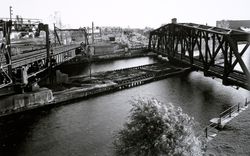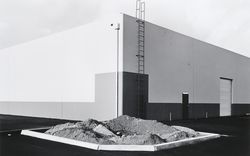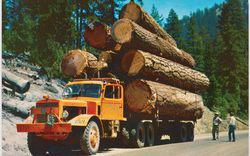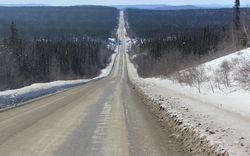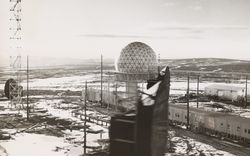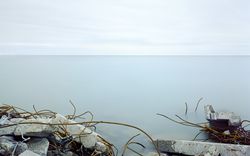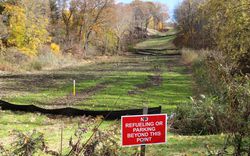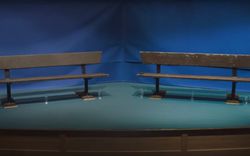Troubled Waters
Text by Ashley Dawson
Polluted by decades worth of cancer-causing polychlorinated biphenyls (PCBs), the Hudson River is the largest Superfund site in the United States.1 Long-standing efforts to clean up the river have only been partially successful, and now the integrity of the Hudson and the communities that lie along its shores is threatened by a series of fossil capitalist infrastructure schemes whose rapacious folly beggars the imagination. Despite these threats, it would not be an exaggeration to say that the Hudson remains at the heart of American identity. During the nineteenth century, images of the Hudson River Valley by painters such as Albert Bierstadt and Thomas Cole helped generate a sense of the United States as an exceptional nation, whose inhabitants were blessed to live amidst a cornucopia of unparalleled natural abundance. Although the mighty Hudson appears today much as it did in paintings such as Bierstadt’s View of the Hudson Looking Across the Tappan Zee Towards Hook Mountain, you cannot eat the fish that swim and spawn in its waters without seriously endangering your health. An invisible infrastructure full of risks permeates the Hudson, a hidden legacy of toxic industries past and present with dramatic implications for the river and the millions who live along its banks.
If the Hudson was a symbol of national promise in the nineteenth century, the river also came to embody the toxic byproducts of the nation’s industrial development as the manufacturing firms that developed along its banks began using the Hudson as an open sewer.2 Although many corporations, as well as federal, state, and local government entities, colluded in the polluting behavior that nearly killed the Hudson, among the worst offenders was General Electric (GE), whose two manufacturing plants north of Albany dumped at least 1.3 million pounds of carcinogenic PCBs into the river between 1947 and 1977,3 when the US Congress approved legislation to ban the use of these oily compounds employed as insulating agents in electrical equipment, based on mounting scientific evidence of their toxicity and disruptive impact on endocrine systems during fetal development. Since PCBs are highly mobile, the pollution deposited in the Hudson over these decades travelled not simply all the way down the river to New York’s harbour but around the world. Notably, PCBs have been found in high concentrations in the tissues of Inuit people north of the Arctic Circle.
Read more
Since the 1980s, the US Environmental Protection Agency (EPA) has tried to get GE to clean its PCBs out of the Hudson twice. Each time, the EPA faced serious political backlash from the corporation, and cleanup efforts eventually stalled in the face of stiff resistance from the Reagan administration. A decade later, as stipulated by federal law, the EPA reopened the case. In 2002, after sixteen years during which the agency conducted extensive studies of the movement of PCB hotspots in the river, of the levels of the toxin in fish, of human health risks, and of proposed dredging technologies, the EPA issued a ruling on the Hudson River cleanup. The proposed five-year remediation plan would see 2.65 million cubic yards of PCB-laden sediment dredged up from a forty-mile stretch of the Hudson below the two disused GE factories north of Albany, leading to the removal of one hundred thousand pounds of PCBs from the bottom of the river.
The EPA ruling was a significant victory in the face of steep odds. GE pulled out every stop in its campaign against the EPA’s plans to dredge the Hudson. It sponsored epidemiological studies that claimed no link existed between PCBs and cancer.4 It lobbied Congress against dredging and for cutting agency funding in various ways. GE even took the federal government to court, alleging that the EPA’s ability to order pollution cleanups under the Superfund law was unconstitutional.5 Even more damagingly, GE also spent tens of millions of dollars bankrolling a publicity campaign that sought to terrorize Hudson Valley residents out of supporting the proposed cleanup.c Not only did the corporation threaten to close plants in the Hudson River Valley, putting thousands out of work, but, as part of its anti-dredging campaign, GE also funnelled money to astroturfing groups like the Citizen Environmentalists Against Sludge Encapsulation, and Farmers Against Irresponsible Remediation, who helped disseminate fears concerning the damaging environmental impact of the remediation efforts proposed by the EPA. Some members of the public became worried that dredging up PCB-impregnated sediments from the riverbed would release toxins into the water itself, poisoning the Hudson for years. Although the EPA conducted extensive studies concerning the impact of dredging, which concluded that the cleanup would not exacerbate PCB levels in the river, GE was able to undermine these results by manipulating public distrust of expert opinion concerning the environment. This distrust was further catalyzed by perceived government culpability and duplicity in the case of major environmental disasters, such as the poisoning of the community at Love Canal in the late 1970s.
The Hudson River cleanup controversy was thus part of a larger Right-wing effort to challenge environmentalism through ersatz populism, one that feeds directly into today’s climate denial campaigns. Adding to the din of anti-dredging sentiment, GE ran ads in upstate New York newspapers that stirred up corrosive populist anger at the government’s efforts to remove toxins from the river, with lines like “Opposed to dredging? Unfortunately, you don’t get to vote.” Featuring bucolic images of the river, the GE ads implied that it was the federal government’s remediation efforts rather than the company’s own callous policies and refusal to accept responsibility for decades of pollution that threatened life on the Hudson. In fighting against the EPA-ordered remediation, GE—which is responsible for dozens of Superfund sites across the nation—was fighting a broader campaign against the precedent for corporate responsibility set on the Hudson.
Although the EPA-mandated dredging operation did take place from 2009 to 2015, GE’s political pressure was not without effect. The remediation work ordered by the EPA covered only a forty-mile span of the upper Hudson, from the GE plants in Fort Edward and Hudson Falls down to Troy. Although this span is the most heavily contaminated portion of the river, it only constitutes 20 percent of the entire Superfund site. The idea behind the EPA plan was that once the heavily contaminated portion of the river was purged, the less toxic lower reaches would restore themselves.7 According to Daniel Raichel, a lawyer with the Natural Resources Defense Council, this remedy was flawed from the start because it was based on breaking the Hudson up into separate sections, and then applying far less stringent standards of pollution to the downstream portions of the river. Worse still, after the EPA issued its ruling on remediation in 2002, consultants working for GE conducted tests revealing that the contamination of the Hudson was two to three times worse than expected, and that rates of attenuation of PCBs in the river were far slower than anticipated. The upshot is that dredging has not been nearly as effective as the EPA predicted: it was anticipated that PCB levels in the river would be so low immediately after the dredging that an adult could eat half a pound of fish from the river every two months without suffering any adverse effects. Now, the US National Oceanic and Atmospheric Administration (NOAA) modelling has revealed that it will in fact take at least forty more years for contamination levels in the river to decrease to those originally anticipated by the EPA.8 So, despite the mandate of the Superfund law, which stipulates clearly that the EPA is responsible for making sure that polluted sites are clean and safe for humans and other living beings, the Hudson River is likely to remain toxic for several generations. Other science-based federal agencies such as NOAA and the Fish and Wildlife Service are now clashing with the EPA, arguing that they cannot follow through with the restoration efforts with which they are charged, since the EPA has essentially allowed GE to leave behind a series of Superfund sites along the Hudson River.9
-
Superfund is a United States federal government program that funds cleanup of sites polluted with hazardous substances. Initiated in 1980, the program authorizes the Environmental Protection Agency to identify parties responsible for releasing hazardous substances, and either compel them to clean up the site or undertake remediation itself using the Superfund and costs recovered from polluters. ↩
-
For an overview of this history of industrial development and riverine pollution, see John Cronin and Robert F Kennedy, Jr., The Riverkeepers: Two Activists Fight to Reclaim Our Environment as a Basic Human Right (New York: Scribner, 1997). ↩
-
“Hudson River PCBs,” Riverkeeper, accessed 15 December 2016. ↩
-
Charlie Cray, “Toxics on the Hudson: The Saga of GE, PCBs, and the Hudson River,” Multinational Monitor 22, 7/8 (July/August 2001). ↩
-
Mary Esch, “GE Loses Appeal of Superfund Case,” Times Union (30 June 2010). ↩
-
Cray. ↩
-
Daniel Raichel, personal interview (12 Oct 2016). ↩
-
Ibid. ↩
-
Ibid. ↩
But the Hudson is not just plagued by the poisonous legacy of the American industrial age. In addition, the river and the communities of humans and animals that live on its verges are increasingly threatened by the toxic infrastructure of our current age of extreme extraction. Beginning in late 2011, freight trains passing down the west bank of the Hudson River began carrying a highly volatile form of crude oil extracted by hydraulic fracturing (aka fracking) from the Bakken shale of North Dakota to East Coast refineries. The trains that transport this hazardous cargo in hundreds of black, pill-shaped container cars, each holding thirty thousand gallons (the equivalent of 2 million sticks of dynamite) of highly flammable and toxic fuel, are called “bomb trains” by railroad workers. Several of these ominous-looking trains snake south every day from the port of Albany, where they pass within fifteen feet (less than five metres) of a public housing complex, to the large refinery in Philadelphia.1 The bomb trains have earned their nickname: in 2013, one such train derailed and exploded in Lac Mégantic, Québec, killing forty-seven people and dumping hundreds of thousands of gallons of crude oil into the local river. As the amount of volatile crude shipped by rail has skyrocketed, from only nine thousand black rail cars in 2009 to over five hundred thousand today, so have the number of explosions. Despite this massive increase in rail traffic, “bomb trains” are not the only means by which crude oil is transported along the Hudson. As a result of the current glut of fossil fuels, crude is being shipped down the Hudson River not just by trains but also by barges, which carried three billion gallons of oil down the river from Albany in 2015. The US Coast Guard is currently considering creating forty three new anchorage sites for container ships along the Hudson, essentially turning 2,400 acres of the river into parking lots for these bomb barges.2
Adding significantly to this toxic infrastructure, fossil fuel corporations are also pushing forward with the construction of pipelines designed to transport fracked petroleum and tar sands oil down the Hudson, including the Pilgrim Pipeline, slated to stretch 170 miles (275 kilometres) down the west side of the Hudson river. The Pilgrim Pipeline will cut through over fifty towns in New York and New Jersey, as well as numerous wetlands and tributaries of the Hudson, with its freight of dangerous fracked oil, threatening local water supplies and spreading air pollution even barring a catastrophic rupture. Multiplying this risk massively, the Algonquin Incremental Market pipeline was drilled by the Spectra Energy Corporation underneath the Hudson River, within hundreds of feet (a few hundred metres) of the aging Indian Point nuclear power plant in Buchanan, New York—located just thirty miles (less than fifty kilometres) north of Times Square, having itself a history of leaks, small fires, and spills that dates back to its opening in 1962. Since Spectra Energy could not get clearance to drill underneath the nuclear power plant, it linked the wide pipeline it bored underneath the Hudson to an old, smaller-diameter pipeline laid before Indian Point was built. Given that one of the biggest contributors to deadly pipeline explosions in the United States is the aging of the nation’s fossil fuel infrastructure, Spectra’s plans to ship volatile crude through a sixty-year old pipeline beneath a nuclear reactor built just outside the nation’s largest city is nothing short of criminal. 3
If we are to avoid catastrophic climate change, we cannot build any more pipelines or dig any more coal mines. As Bill McKibben recently put it: “We’re done expanding the fossil fuel frontier.” 4 The struggle against the deadly expansionist logic of fossil capitalism is now playing out with great visibility at Standing Rock in North Dakota. Yet Standing Rock is not the only site of struggle against fossil capitalism. The hazardous infrastructure of extreme extraction is coming to a town, river, or waterfront near you, if it’s not already hiding there. The United States and Canada have nearly 5 million kilometres (more than 3 million miles) of pipeline and are adding new infrastructure at a frenetic rate. This expanding skein of oil and gas industry infrastructure causes hundreds of accidents every year, and also contributes to the slow violence of climate change through systemic leaks of greenhouse gases such as methane. While pipeline accidents are relatively infrequent in statistical terms—trucking accidents, for example, kill four times as many people each year on average as pipeline ruptures—when pipelines do burst, they cause catastrophic damage. 5 In addition, pipelines like those beneath the Indian Point nuclear power plant stay underground, their condition unmonitored for decades, until a cataclysm occurs. Yet aging pipelines are not the only problem: recently installed pipelines have a failure rate equivalent to that of century-old ones, reflecting a contemporary rush to install infrastructure in order to cope with the surplus of oil and gas produced by the fracking revolution. This surplus is so great that much of the hidden fossil capitalist infrastructure is not being installed to foster “energy independence,” but rather to facilitate export of gas and oil to more lucrative markets abroad. In the process, some of the most iconic sites in the United States are being threatened. This is certainly true along the Hudson River. If the Hudson River Valley was once a symbol of the New World’s promise, of the great natural abundance that defined America as a nation, it has registered many of the tribulations of the Anthropocene Age. Still polluted by the toxic legacy of the industrial age that propelled the United States to global hegemony, the Hudson is now on the frontlines of a fight against forms of extreme extraction that constitute nothing short of an existential threat to humanity’s future on the planet.
-
Leanne Tory-Murphy, “Bomb Trains on the Hudson,” The Indypendent (15 Aug 2016). ↩
-
Scenic Hudson, “Proposed Hudson River Anchorages,” ↩
-
Lena Groeger, “Pipelines Explained: How Safe Are America’s 2.5 Million Miles of Pipeline?”, ProPublica (15 Nov 2012). ↩
-
Bill McKibben, “Recalculating the Climate Math,” New Republic (22 Sept 2016). ↩
-
Lena Groeger. ↩
The author would like to thank the following people for sharing their deep knowledge of the Hudson: Kim Fraczek, Manna Jo Greene, Kathryn Jahn, Daniel Raichel, and Nancy Vann. All opinions expressed in the article are entirely the author’s own.
Ashley Dawson was a guest speaker at the CCA as part of Toolkit for Today 2016{:target=”blank”}. He is the author of _Extinction: a Radical History (OR Books, 2016).
